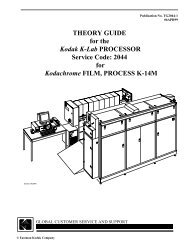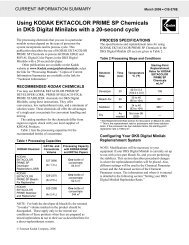You also want an ePaper? Increase the reach of your titles
YUMPU automatically turns print PDFs into web optimized ePapers that Google loves.
FEATURES<br />
<strong>Konica</strong> <strong>Color</strong> <strong>VX</strong> <strong>SUPER</strong> <strong>200</strong> is an ISO <strong>200</strong>/24° color film balanced for<br />
daylight. It is a general multi-purpose film with bright color reproduction.<br />
The <strong>VX</strong> <strong>SUPER</strong> series utilizes <strong>Konica</strong>’s latest emulsion technologies and<br />
extremely improved actual speed, granularity and latent image stability<br />
compared to the prior <strong>VX</strong> series.<br />
This film is an excellent choice for a wide variety of outdoor shooting<br />
situations. It also delivers brilliant colors under flash lighting. Superior<br />
resistance to heat and humidity allows you to use this film with confidence in<br />
any situation.<br />
LAYER STRUCTURE BEFORE PROCESSING AFTER PROCESSING<br />
Protective layer<br />
Inter layer<br />
Blue sensitive layer<br />
Yellow filter layer<br />
Green sensitive layer<br />
Inter layer<br />
Red sensitive layer<br />
Inter layer<br />
Anti-halation layer<br />
<strong>Film</strong> base<br />
FILM BASE Triacetate base<br />
FILM SIZES AVAILABLE 135 size:<br />
EMULSION NUMBER #700~#799<br />
DX-CODE 28-6<br />
<strong>Konica</strong> <strong>Color</strong><br />
<strong>VX</strong> <strong>SUPER</strong> <strong>200</strong> <strong>Film</strong><br />
Yellow dye negative image<br />
Magenta dye negative image<br />
and residual colored coupler<br />
Cyan dye negative image<br />
and residual colored coupler<br />
FILM SPEED EXPOSURE CONDITIONS<br />
<strong>Konica</strong> <strong>Color</strong> <strong>VX</strong> <strong>SUPER</strong> <strong>200</strong> is designed for use with daylight and electronic<br />
flash. While color-balanced for daylight, this film is designed to retain optimum<br />
spectral sensitivity and yield satisfactory results when exposed under<br />
tungsten or fluorescent light, as well. For best results with these light sources,<br />
however, the use of appropriate filters is recommended.<br />
Light Source<br />
ISO Speed Light Balancing Filter<br />
Daylight or Electronic Flash <strong>200</strong>/24°<br />
None<br />
Photolamp (3400K)<br />
64/19°*<br />
Wratten No. 80B<br />
Tungsten (3<strong>200</strong>K) 50/18°*<br />
Wratten No. 80A<br />
*Includes the exposure factor to obtain best color results without special printing.
<strong>Konica</strong> <strong>Color</strong> <strong>VX</strong> <strong>SUPER</strong> <strong>200</strong> <strong>Film</strong><br />
RECIPROCITY CHARACTERISTICS<br />
A wide range of shutter speeds (i.e.1/10000 ~1sec.) can be used without loss<br />
of film speed and tone reproduction.<br />
To compensate for reciprocity failure, use the following data as a guide:<br />
RECIPROCITY FAILURE COMPENSATION GUIDE<br />
Exposure time (in seconds)<br />
Exposure Compensation<br />
<strong>Color</strong> Compensating Filters<br />
1/10000~1<br />
None<br />
None<br />
DAYLIGHT EXPOSURE EXPOSURE GUIDE TABLE: Outdoors under daylight.<br />
Bright<br />
sunlight<br />
(Seascape,<br />
Snow scene)<br />
10<br />
+1 stop<br />
None<br />
ELECTRONIC FLASH EXPOSURE<br />
No filter required.<br />
To determine the lens opening, divide the guide number by the flash-to-subject<br />
distance. If negatives are over exposed, use a higher guide number; if they’re<br />
under-exposed, use a lower number.<br />
STANDARD PROCESSING <strong>Konica</strong> <strong>Color</strong> Negative <strong>Film</strong> Process CNK Series or Process C-41<br />
SPECTRAL SENSITIVITY• CHARACTERISTIC CURVES<br />
Relative Speed (log)<br />
1.0<br />
Conditions<br />
Lens<br />
opening<br />
Shutter<br />
speed<br />
Bright<br />
sunlight<br />
Hazy<br />
sunlight<br />
Cloudy<br />
bright<br />
Cloudy dull,<br />
Open shade<br />
f/22 f/16 f/11 f/8 f/5.6<br />
1/250 sec. 1/250 sec. 1/250 sec. 1/250 sec. 1/250 sec.<br />
This table is applicable for exposures from 2 hours after sunrise to 2 hours<br />
before sunset.<br />
The use of an exposure meter is highly recommended in cloudy weather or in<br />
open shade since light intensity differentials are in continual flux.<br />
Apertures increased by one or two stops are usually suitable for back-lighted,<br />
close-up subjects.<br />
SPECTRAL SENSITIVITY CHARACTERISTIC CURVES<br />
B<br />
G<br />
Process: CNK-4<br />
Densitometry: Status M<br />
Density: 1.0 above D min.<br />
400 500 600 700<br />
Wavelength (nm)<br />
R<br />
Density (D)<br />
3.0<br />
2.0<br />
1.0<br />
Exposure: Daylight 1/125 sec.<br />
Process: CNK-4<br />
Densitometry: Status M<br />
3.0 2.0 1.0 0.0 1.0<br />
log H<br />
B<br />
G<br />
R
GRANULARITY DIFFUSE R.M.S. GRANULARITY: 4<br />
Aperture diameter: 48µmø<br />
SPECTRAL DYE DENSITY CURVES • SHARPNESS<br />
Diffuse Spectral Density (D)<br />
2.5<br />
2.0<br />
1.5<br />
1.0<br />
0.5<br />
SPECTRAL DYE DENSITY<br />
CURVES<br />
* Typical densities for<br />
a midscale neutral subject and D min.<br />
Midscale Density<br />
Minimum Density<br />
Process: CNK-4<br />
0<br />
400 500 600 700<br />
Wavelength (nm)<br />
RESOLVING POWER Test-Object Contrast 1.6:1—050 lines/mm<br />
Test-Object Contrast 1000:1—100 lines/mm<br />
TECHNICAL DATA SHEET<br />
MODULATION TRANSFER<br />
FUNCTION<br />
Exposure: Daylight<br />
Process: CNK-4<br />
Densitometry: Through visual filter<br />
PRECAUTIONS <strong>Konica</strong> <strong>Color</strong> <strong>VX</strong> <strong>SUPER</strong> <strong>200</strong> film features enhanced raw stock and latent<br />
image stability, and resistance to harmful gases. However, the following<br />
precautions must be observed in handling color negative films:<br />
1.iHANDLING OF FILM: Avoid direct sunlgiht or other strong light when loading<br />
or unloading camera.<br />
2.iPROCESSING AND PRINTING: Process and print promptly after exposure<br />
to minimize effects of latent image change.<br />
3.iSTORAGE OF FILM: Keep unused film in a cool, dry place such as a<br />
refrigerator. (Storage at below 10°C or 50°F is recommended.)<br />
Avoid the following conditions:<br />
i)ii High temperature and high humidity.<br />
ii)i Exposure to harmful gases such as formaldehyde.<br />
iii) Leaving film in camera for extended periods.<br />
4.iEXPIRATION DATE OF FILM: For best results, process before expiration<br />
date stamped on package.<br />
5.iSTORAGE OF PROCESSED FILM: Keep processed film in a cool, dry and<br />
dark place to minimize fading of dyes.<br />
NOTICE: The characteristic curves and data in this publication represent test results obtained under<br />
the specified conditions of exposure and processing. The manufacturer reserves the right to modify<br />
product characteristics at any time.<br />
100<br />
Response (%)<br />
50<br />
10<br />
5<br />
1<br />
1 5 10 50 100<br />
Spatial frequency (Cycles/mm)

















